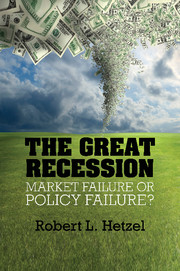Book contents
- Frontmatter
- Contents
- Figures
- Tables
- Preface
- One The 2008–2009 Recession
- Two Recessions
- Three The Great Contraction
- Four Monetary Policy and Bank Runs in the Great Depression
- Five Vigorous Recovery and Relapse
- Six Interwar International Monetary Experiments
- Seven Identifying the Shocks that Cause Recessions
- Eight From Stop-Go to the Great Moderation
- Nine Controlling Bank Risk Taking
- Ten The Housing Crash
- Eleven Bubble Trouble
- Twelve What Caused the Great Recession of 2008–2009?
- Thirteen What Caused the Great Leverage Collapse?
- Fourteen The Distinctions Between Credit, Monetary, and Liquidity Policy
- Fifteen Fed Market Interventions
- Sixteen Evaluating Policy
- Seventeen The Business Cycle
- Eighteen Why Is Learning So Hard?
- Nineteen How Should Society Regulate Capitalism?
- Postscript
- Bibliography
- Index
Two - Recessions
Financial Instability or Monetary Mismanagement?
Published online by Cambridge University Press: 05 May 2012
- Frontmatter
- Contents
- Figures
- Tables
- Preface
- One The 2008–2009 Recession
- Two Recessions
- Three The Great Contraction
- Four Monetary Policy and Bank Runs in the Great Depression
- Five Vigorous Recovery and Relapse
- Six Interwar International Monetary Experiments
- Seven Identifying the Shocks that Cause Recessions
- Eight From Stop-Go to the Great Moderation
- Nine Controlling Bank Risk Taking
- Ten The Housing Crash
- Eleven Bubble Trouble
- Twelve What Caused the Great Recession of 2008–2009?
- Thirteen What Caused the Great Leverage Collapse?
- Fourteen The Distinctions Between Credit, Monetary, and Liquidity Policy
- Fifteen Fed Market Interventions
- Sixteen Evaluating Policy
- Seventeen The Business Cycle
- Eighteen Why Is Learning So Hard?
- Nineteen How Should Society Regulate Capitalism?
- Postscript
- Bibliography
- Index
Summary
Popular commentary on the 2008–2009 recession has revived the market-disorder view. According to the variant that dominated thinking in the nineteenth century and first half of the twentieth century, a combination of easy money and speculative greed creates asset bubbles, which when deflated require a purgative cleansing of debt that produces deflation and recession. This understanding of recession as the outcome of unrestrained financial speculation motivated the original Federal Reserve Act. Acting on the basis of this speculative-excess or real-bills view, the Fed’s founders established the Fed to eliminate the periodic recessions they associated with excessively risky lending by banks and the subsequent forced liquidation of the resulting bad debt.
According to the real-bills view, the business cycle originates in speculation that creates unsustainable asset bubbles. The monetary-disorder view instead emphasizes money creation and destruction that interferes with operation of the price system. To illustrate the perennial nature of the debate, this chapter reviews the contemporaneous commentary on the 1818–1819 deflation and recession in the United States and then contrasts this commentary with later analysis in the monetary-disorder (quantity theory) tradition.
These contrasting views give rise to contrasting views on the stability of the banking system. Does unrestrained speculation periodically lead to a cycle of boom and bust for banks that destabilizes the real economy? This chapter also reviews the record of financial stability in the era before the establishment of the Fed, the National Banking era. Did the absence of a financial safety net turn the banking system into a source of economic instability?
- Type
- Chapter
- Information
- The Great RecessionMarket Failure or Policy Failure?, pp. 11 - 22Publisher: Cambridge University PressPrint publication year: 2012

